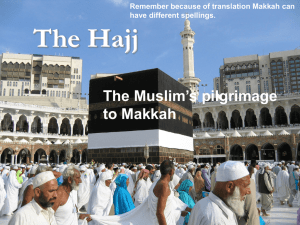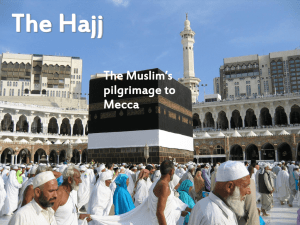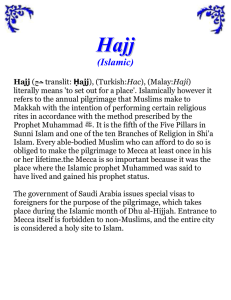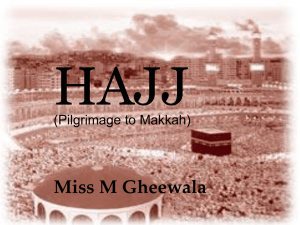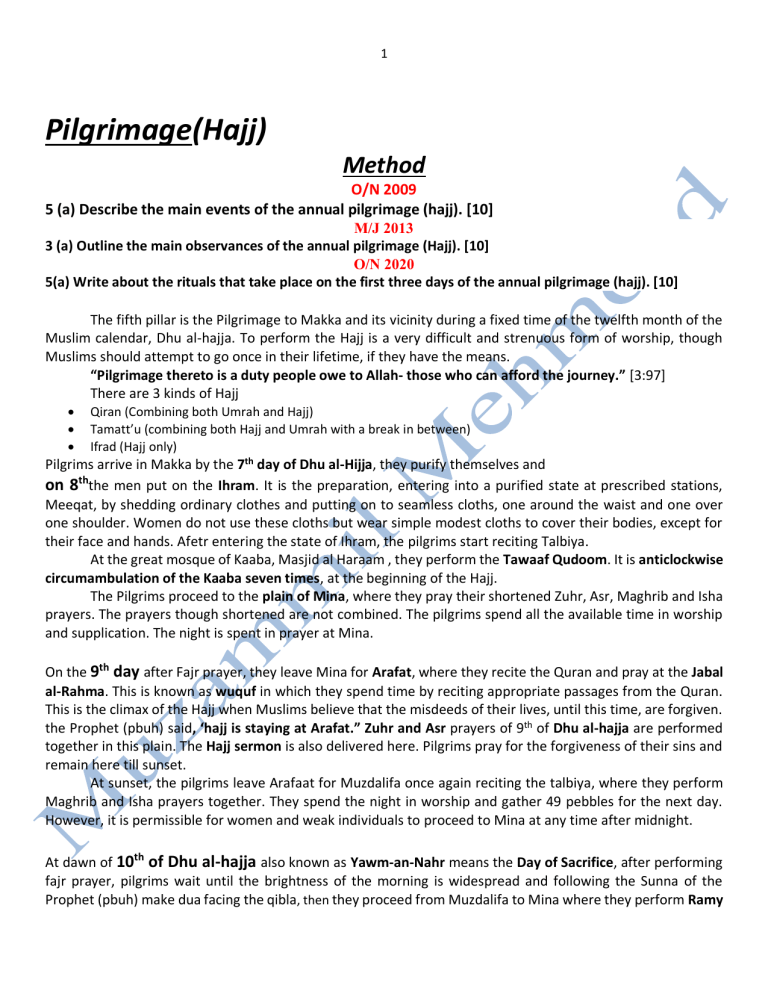
1 Pilgrimage(Hajj) Method O/N 2009 5 (a) Describe the main events of the annual pilgrimage (hajj). [10] M/J 2013 3 (a) Outline the main observances of the annual pilgrimage (Hajj). [10] O/N 2020 5(a) Write about the rituals that take place on the first three days of the annual pilgrimage (hajj). [10] The fifth pillar is the Pilgrimage to Makka and its vicinity during a fixed time of the twelfth month of the Muslim calendar, Dhu al-hajja. To perform the Hajj is a very difficult and strenuous form of worship, though Muslims should attempt to go once in their lifetime, if they have the means. “Pilgrimage thereto is a duty people owe to Allah- those who can afford the journey.” [3:97] There are 3 kinds of Hajj • • • Qiran (Combining both Umrah and Hajj) Tamatt’u (combining both Hajj and Umrah with a break in between) Ifrad (Hajj only) Pilgrims arrive in Makka by the 7th day of Dhu al-Hijja, they purify themselves and on 8ththe men put on the Ihram. It is the preparation, entering into a purified state at prescribed stations, Meeqat, by shedding ordinary clothes and putting on to seamless cloths, one around the waist and one over one shoulder. Women do not use these cloths but wear simple modest cloths to cover their bodies, except for their face and hands. Afetr entering the state of Ihram, the pilgrims start reciting Talbiya. At the great mosque of Kaaba, Masjid al Haraam , they perform the Tawaaf Qudoom. It is anticlockwise circumambulation of the Kaaba seven times, at the beginning of the Hajj. The Pilgrims proceed to the plain of Mina, where they pray their shortened Zuhr, Asr, Maghrib and Isha prayers. The prayers though shortened are not combined. The pilgrims spend all the available time in worship and supplication. The night is spent in prayer at Mina. On the 9th day after Fajr prayer, they leave Mina for Arafat, where they recite the Quran and pray at the Jabal al-Rahma. This is known as wuquf in which they spend time by reciting appropriate passages from the Quran. This is the climax of the Hajj when Muslims believe that the misdeeds of their lives, until this time, are forgiven. the Prophet (pbuh) said, ‘hajj is staying at Arafat.” Zuhr and Asr prayers of 9th of Dhu al-hajja are performed together in this plain. The Hajj sermon is also delivered here. Pilgrims pray for the forgiveness of their sins and remain here till sunset. At sunset, the pilgrims leave Arafaat for Muzdalifa once again reciting the talbiya, where they perform Maghrib and Isha prayers together. They spend the night in worship and gather 49 pebbles for the next day. However, it is permissible for women and weak individuals to proceed to Mina at any time after midnight. At dawn of 10th of Dhu al-hajja also known as Yawm-an-Nahr means the Day of Sacrifice, after performing fajr prayer, pilgrims wait until the brightness of the morning is widespread and following the Sunna of the Prophet (pbuh) make dua facing the qibla, then they proceed from Muzdalifa to Mina where they perform Ramy 2 (stonning), by throwing seven pebbles at the Jamarat al Aqba calling ‘Bismillah Allahu Akbar’ every time they throw a pebble.. The stone pillar symbolizes Satan. Recitation of Talbiah is stopped here. The animal sacrifice is offered at Mina. Men usually have their heads shaved at this time whereas women may cut a lock of hair equal to fingertips. They can now change into their normal clothes. Quran says, “The sacrificial camels, We have made for you as among the symbols from Allah: in them is much good for you. Then pronounce the name of Allah over them as they are lined up for sacrifice. When they are down on their sides after slaughter, eat from them and feed others.” [22:36] After this, the pilgrims go to the Kaaba to perform the obligatory tawaf known as Tawaf Ifadah or Tawaf Ziara. Then they perform two rakat near the Station of Ibrahim. Then they carry out the Sa’yi between the hills of Safa and Marwa by running between the hills seven times. Only men are required to walk briskly, women may walk at their normal pace. Quran says, “Behold! Safa and Marwa are among the symbols of Allah. So if those who visit the house in the season or at other times, should compass them round.” [2:158] Ramy is carried out on the eleventh and the twelfth days as well. On the twelfth day, pilgrims return to the Kaaba for the final Tawaaf (wida). M/J 2016 4 (a) ‘And complete the hajj or umra in the service of God’ (al-Baqara 2:196). What observances does a pilgrim complete in the performance of umra and how is umra different to hajj? [10] Method of Umrah: ‘Umrah in Islamic terminology, means paying a visit to Ka’bah, performing Tawaaf (circumambulation) around it, walking between Safaa and Marwah seven times. A performer of ‘Umrah puts off his Ihraam by having his hair shaved or cut. ‘Umrah can be performed along with Hajj and in other days as well. 1. When the one who wants to perform ‘Umrah arrives at the Meeqaat, it is recommended for him (both man and woman) to take a bath if convenient. Women only need to make their intention at that time in the clothing they are already wearing. As for men, they must assume their Ihraam at the Meeqaat by wearing two pieces of fabric called the Izaar and the Ridaa’. The Ridaa’ covers the top half of the body, while the Izaar covers the lower half. No other clothing is allowed to be worn in addition to these. Then the pilgrim makes the intention at the Meeqaat to begin the rites of ‘Umrah by entering the state of Ihraam. The intention must be made in the heart. 2. After the intention Talbiyyah is recited. Upon arriving at the sacred mosque in Makkah (Al-Masjid Al-Haraam), you should enter with your right foot and stop reciting Talbiya. 3. Upon arriving at the Ka’bah, approach the Black Stone, touch it with your right hand and kiss it. If this isn't possible, you should face the Black Stone and point to it. When touching the Stone, the following is said: (In the name of Allah, Allah is the Greatest) . If this is difficult for you, then go on performing tawaaf without touching it. 4. When you complete seven circuits of Tawaaf, approach Maqam Ibrahim recite this verse (which means): “And take you (people) the Maqaam (place) of Ibraheem as a place of Prayer...” [Quran: 2:125] Then pray two short Rak’ahs, as close as conveniently possible, behind MaqaamIbraheem. Upon completing the two Rak'ahs, return to the Black Stone and touch it, if convenient 5. The next stage is to go to Safaa. Upon approaching the foot of Safaa, the following verse is recited (which means): “Verily, As-Safaa and Al-Marwah are from the symbols of Allah.” [Quran; 2:158] Then descend and go towards 3 Marwah, There are no particular supplications to be recited between Safaa and Marwah. Seven circuits are to be completed ending the last one on Marwah. 6. Then one is to have his hair cut although shaving it is better. Women should shorten their hair by a finger-tips length from the end. The rites of 'Umrah have now been completed. The main differences between Hajj and Umra • • • • • • • Hajj is one of the five pillars of Islam and is an obligatory act of worship for those of good health and can afford the journey whereas Umra is not an obligatory act. Hajj can only be performed during prescribed month and dates i.e. Zil Hajj (7th – 12th) whereas Umra can be performed at any time of the year. Wuquf Arafat is one of the most important components of Hajj without which Hajj is void. However, there is no Wuquf Arafat in Umra. Similarly there is no WuqufMuzdailfa (spending the night at Muzdailfa) in Umra or combining Maghrib and Isha prayers. In Hajj, Talbiah is stopped on the 10th of Zil Hajj after the stoning of the devil (Rami) whereas Talbiah is stopped while starting the Tawaf in Umra. In Hajj, a person has to go and stay in Mina, perform Rami at the Jamarat while there is no stay at Mina or Rami in Umra. In Hajj, the pilgrim gives a sacrifice on 10thZil Hajj while no sacrifice is offered in Umra. Benefits/Importance of Pilgrimage M/J 2014 4 (a) How do Muslim individuals and the Muslim community benefit from the annual pilgrimage (hajj)? [10] • 1. 2. 3. 4. Hajj is fifth pillar of Islam. It became obligatory in the ninth year of Hijrah. Hajj is an act of Ibadah which is obligatory on every Muslim who can afford it once in his lifetime. Hajj literally means the intenion of going on Pilgrimage. It is an all embracing act of worship in which a Muslims visits the Ka’bah in the month of Dhul-Hajj and performs him prescribed rites Allah says, “Pilgrimage there to is a duty people owe to Allah, those who can afford the journey.” Hajj is a form of worship which covers all aspects of human life. It trains a Muslim to sacrifice his wealth his time his physical and mental energies and his comfort in the way Allah. Allah forgive sins of those who perform pilgrimage and does not care for those who die without performing it, the Prophet (P.B.U.H) said, “He who is not prevented from performing the Pilgrimage by an obvious necessity, a tyrannical ruler, or a disease which confines him at home, and dies without having performed the Pilgrimage may die if he wishes to be Jew or Christian.” The Prophet (P.B.U.H) said, “An accepted Pilgrimage has no reward except paradise.” (Agreed). One of the most important benefit of Hajj is that it demonstrates equality and brotherhood among the Muslims. People of all nationalities, all colors, races and the ranks from all over the world assemble at one place and interact with each other. They come before their creator in extreme humility, wearing two white sheets without any distinction between the high and the low, the king or the servant, gather at the same place and utter the same words, Hajj is a great spiritual experience. It brings the pilgrim closer to Allah, and he feels that the entire barrier between him and his Creator are removed. In the plain of Arafat on this great occasion hundreds and thousands of people assemble and proclaim together (here I am O Lord! Here I am) and they feel that nothing stands between them and Allah. 4 5. Trading is allowed during Pilgrimage. Allah says, “It is no crime in you, if you seek of the bounty of your Lord (during Pilgrimage)” (Al- Baqrah 2:198) Pilgrim may buy and sell and thus he can meet expanse of his journey. 6. Pilgrimage has other economic benefits for Muslims. People have the opportunity to discuss their economic problem; and the get the chance to devise plans and strategies that may benefits the Muslims on individual level and evolve common economic strategies that are beneficial to the entire Muslim world. 7. The Muslims assemble every year in Makkah; this annual meeting provides the Muslims leaders an opportunity to discuss their common problems and formulate a common policy that can be pursued by all Muslim countries in the United Nations Organizations, the Security Council or other such world forums. It also provides them with opportunity to discuss and agree on many topics of common interest. O/N 2014 4 (a) ‘Pilgrimage to the House is a duty people owe to Allah, those who can afford the journey.’ (Al ‘Imran 3:97) (i) For whom is the annual pilgrimage (hajj) compulsory and which Muslims are exempt from it? (ii) What things are forbidden to pilgrims while in the state of ihram? [10] (i)Obligation and exemption: • • • • • Pilgrimage to Makkah once in a lifetime is obligatory on every adult, sane, free Muslim, who can afford to undertake a journey to Makkah. Allah says, “Pilgrimage thereto is a duty, men owe to Allah those who can afford the journey.” (Al-Imran 3:97) It is obligatory on those who have sufficient money to pay for their return journey to Makkah and meet expanses of their stay and also have ample funds to provide for their dependents back at home until their return Allah says, “ And take a provision(with you) for the journey” (Al-Baqarah 2:197) Pilgrimage is only obligatory on those who are physically fit to undertake the journey. Hajj is not binding on people who are sick or very old, and cannot endure the hardship of long journey. Journeys must be safe danger to life or possessions due to war, epidemic or highway robberies free a person from obligation of Pilgrimage. A woman is not allowed to go to Pilgrimage without mahram. In case, she cannot find a mahram to accompany her, it is not obligatory for her to perform Pilgrimage. Ibn Abbas reported, the Prophet (P.B.U.H) said, “women should not travel except with a mahram, and no man may visit her except in the presence of mahram”, a man got up and said “O Allah’s apostle! I intend to go with such and such an army and my wife wants to perform Hajj” the Prophet (P.B.U.H) said, (to him), “ Go along with her (to Hajj)” (Sahih Bukhari) (ii) prohibitions of Ihram There are a number of other rules connected with Hajj, such a prohibition against using perfume, killing any creature, uprooting or damaging plants, doing anything dishonest, To use abusive or foul language,To hunt or kill an animal; however, harmful or dangerous animals can be killed, carrying weapons, covering the head for men, covering the face and hands for women, wearing shoes over the ankles, cutting hair or clipping nails, and having sexual relations. These restrictions ensure that the pilgrims are focused on what they are doing and concentrating on Allah. Throughout the Hajj they also offer prayers to Allah while making their observances Specific Acts by name: O/N 2017 5 Q4 (a): Outline the various kinds of circumambulations (tawaf) around the Ka’ba required during the annual pilgrimage (hajj) and describe the conditions for performing them. [10] 1. Tawaf and its conditions Tawaf is the circumambulation of the Ka'ba seven times in anticlock wise direction and there are different kinds of tawaf which are performed during hajj. The different kinds of tawaf and the conditions for preforming them are: Tawaf-e-Qudoom: is the tawaf of arrival for hajj. It is performed on entering the sacred mosque. Tawaf-e-Ziara (Tawaf Ifadah) is an obligatory act of pilgrimage and if it is not performed the pilgrimage becomes void. It takes place after the first stoning of the jamarat and it is permissible to perform it from 10th and 12th Zil Hajj. Tawaf-e-Wida (the farewell tawaf), this tawaf is wajib and is performed before the pilgrims depart for their homes. It is done after completing the actions of hajj and when one has decided to leave Mecca. It is obligatory for all pilgrims except women who are menstruating or bleeding following childbirth, and the one who fails to do it must sacrifice an animal of the type that is valid as an udhiyah. Tawaf-e-Nafl It is not required during annual pilgrimage but is however performed by pilgrims to gain extra rewards Conditions: Each of these tawafs must include seven circuits, men are encouraged to perform the first three circuits at a hurried pace, followed by the remaining four at a slower pace. Each time they reach the Black Stone, they should kiss it if possible or raise their hands in salutation saying Allahu Akbar. After which the pilgrim offers two rak’ah behind Maqaam Ibrahim, if possible; if the pilgrim cannot do that then he/she may offer the prayer in any other part of the mosque. Pilgrims should before starting their tawaf make intention (niyyat) and be in the state of wudu. According to some scholars wudu is fard (compulsory) and it is mustahab (recommended) according to other scholars. If you perform wudu then there is no difference of opinion. Except for the specific supplication between the last stretch of each tawaf of the Ka’ba, i.e. between ‘Rukne Yamani’ and ‘Hajar Aswad’, there are no specific or particular duas which one needs to recite during the tawaf. It is sunna to recite this supplication during the last stretch of each tawaf: Sura Baqarah 2:201 – ‘O our Lord, give us the good in the world, and give us the good in the Hereafter, and save us from the torment of the Hell Fire’ M/J 2011 5 (a) What beliefs and practices are involved in: (i) stoning the Jamarat (ii) performing sa’y (iii) assembling at Arafat [10] O/N 2018 5(a) Write a detailed account of the following: [10] ● ihram; ● tawaf ; and ● sa’i 6 O/N 2019 4(a) Describe any three of the following elements of pilgrimage (hajj): [10] • ihram (garments worn for pilgrimage) • sa’i (running between the hills of Safa and Marwa) • rami (stoning the Jamarrat) • Qurbani (sacrifice). M/J 2022 5 (a) Give an account of the significance of the following: • Day of ‘Arafah • Eid-ul Adha 2. Sayiis walking briskly seven times between Safa and Marwa hills. Sayi is commenced from Safa and ends at Marwa. The commandment about Sayi is contained in the Quran: “Behold! Safa and Marwa are among the symbols of Allah. So if those who visit the house in the season or at other times, should compass them round…..” (2:158) The pilgrim should first climb on the Safa hill. It is not necessary t climb to the top of the hill. He should climb to such a height only as would afford a view of the Kaaba. After descending from Safa, the pilgrim should move towards Marwa and, thereafter, walk briskly between the two hills. Only men are required to walk briskly. Women may walk at their normal pace. HazratHajra, wife of Hazrat Ibrahim, ran several times between these two hills in search of water for her infant son, Ismail. Sayi is performed in memory of this act. This ritual shows respect for maternal love and gratitude to Allah. 3. Head Shaving or Shortening Hair After Sayi pilgrims may shave their head or shorten hair and then may come out of Ihram. The women only cut a lock of the hair. The practice of shaving or clipping hair is affirmed by the Quran and the Sunnah of the Prophet (P.B.U.H), Allah says “Truly did Allah fulfill the vision for his Messenger, you shall enter the Sacred Mosque if Allah wills, with minds secure, heads shaved, hair cut short and without fear.” (Al-Fat-h 48:27). A person may shorten his hair or shave his head, but shaving carries more reward the Prophet (P.B.U.H) blessed those who shaved three times more than those who just shorten their hair Abu Hurairah reported, “Allah’s Apostle said, o Allah! Forgive those who get their heads shaved, the people asked. “Also those who get their hair cut short?” the Prophet said “O Allah Forgive those who have their heads shaved.” The people said, “Also those who get their hair cut short?” The prophet (invoke Allah for those who have their heads shaved and) at the third time said, “also (forgive) those who get their hair cut short.” 4. Rami at Jamarat The three stone pillars situated in Mina are called Jamarat. One nearest to Makkah is called Jamarat-al-Uqba, the second which is near the mosque of Mina is called Jamarat-al-Wusta. At a little distance from this place is the Jamarat-al-Sughra. It is reported that Satan tried to deceive and mislead Hazrat Ibrahim at these three places and Hazrat Ibrahim stoned the devil. In memory of this, the devil is symbolically stoned at Mina during Hajj. It is to show that we reject the devil and obey no one but Allah. The act of stoning the devil is called Rami. The approved method of doing Rami is to stand about five or six feet from the stone pillar, hold the pebble with the thumb and forefinger of the right hand and throw each pebble one after other and while doing so, the following is to be recited, “In the name of Allah, the most Gracious, the most Merciful. Allah is great.” The pebbles should fall as close to the pillar as possible. 7 5. The Ka’ba was built by Adam, and later restored by Ibrahim and Isma’il, and again in the time of the Prophet. • It was the first sanctuary in which God was worshipped. • It is the focus of Muslim prayer from all parts of the world. • It is the first point in Makka that most pilgrims make for. • During pilgrimage Muslims circumambulate it seven times. • They try to kiss the Black Stone as they pass it following the Prophet’s example. 6. Ihram is the state of purity which Muslims enter when beginning the pilgrimage. • The chief sign is for men two pieces of white cloth worn around them. • For women it is normal clothes covering the whole body except face and hands. • It removes signs of distinction and makes all pilgrims appear equal. • In the state of ihram the pilgrim comes under particular restrictions of conduct, such as no cutting of hair or nails. Kinds of Ihram For hajj, Ihram is of three kinds. • Qiran (Combining both Umrah and Hajj) • Tamatt’u (combining both Hajj and Umrah with a break in between) • Ifrad (Hajj only) All these three kinds are legitimate. Aishah reported, “We left (Madinah) with Allah’s Messenger (P.B.U.H) to perform the farewell Hajj. Some of us declared Ihram to perform Umrah while other declared their intentions to perform both Hajj and Umrah. Yet others declared their Ihram to perform Hajj only. The Prophet (P.B.U.H) declared Ihram for Hajj only. As for those who intended Umrah they terminated their Ihram as soon as they finished the rituals of Umrah. Those who intended to combine Hajj with Umrah or those who intended to perform Hajj only they did not terminate their Ihram until the Slaughtering Day (Yawn un-Nahr), the 10th of Dhul-Hijjah” (agreed) 7. Talbiyah Talbiyah is the proclamation of following words “I respond to your call o Allah! I respond to your call and I am obedient to your orders, you have no partner, I respond to your call. All the praises and blessings are for you, all the sovereignty is for you, and You have no partners with you” As soon as the pilgrim enters the state of Ihram he must proclaim Talbiyah loudly. The pilgrim proclaims Talbiyah throughout his journey when he rides his conveyance and sets out for his journey; meets a group or a person early in the morning and after every prescribed prayer. Jabir reported that the Prophet (P.B.U.H) said, “Whosoever makes intention to perform Hajj and pronounces Talbiyah all day until sunset, Allah the Almighty will forgive his sins, and he will be free of sin as he was the day his mother gave birth to him” (Ibn-Majah) 8. ‘Arafat is is a vast empty plain outside Makka where all pilgrims gather during the annual pilgrimage. Here they perform the wuquf, standing between noon and dusk in order to obtain God’s forgiveness. Day of ‘Arafah is on the ninth day of Dhul Hijja and is the climax of Hajj and hence significant in Islam and to Muslims. ‘Arafah, and it was here on the Mount of Mercy (Jabl-al-Rahmah) where the Prophet (pbuh) gave the Last Sermon and received the last revelation before his passing. Wuqoof-al-‘Arafah is one of the greatest worships. It is the day of forgiveness of sins, the Prophet (pbuh) said: ‘Hajj is halting at ‘Arafah’. On this day the gathering of people here from all corners of the world shows that social origin, race, ethnic orientation, wealth and profession have no bearing on the basic spiritual and human qualities. Pilgrims gather at ‘Arafah where they offer shortened and combined Zuhr and Asr prayers with one adhan and two iqamats and stay within the boundaries of ‘Arafah till sunset. This scene is also a reminder of the Day of Judgment where all humanity will assemble to account for their deeds before God, and where the final judgment will take place. 8 9. Sacrifice (‘Id al-Adha) The practice of sacrifice is commemorated annually as a rite of the Hajj on the tenth of Dhul-Hajj on Eid al-Adha in Memory of the great Sacrifice of Ibrahim and Ismail. The Prophet Ibrahim had a dream ordering him to sacrifice his son, when he narrated his dream to Ismail he immediately offered to comply with the command of Allah, Allah says, “And when (his son) was old enough to work with him (Abraham) said o my dear son I have seen in a dream that I must sacrifice you. So look what do you think? He said o my father! Do that what you are commanded. Allah willing you shall find me of the steadfast.” (As-Saffat 37:102) Sacrifice is offered after rammi on jamarattulaqabah. A sacrificial animal may be acamel, a cow or a lamb. A camel must be atleast five years old, a cow two years old and a goat a year old at least. The animal should be healthy and free from all physical defects. Muslims all over the world offer the sacrifice and celebarated Eid ul Adha on that day. Allah’s Messenger (P.B.U.H) said, “On the day of sacrifice no one does a deed more pleasing to Allah than the shedding of blood. The sacrifice will come on the day of Resurrection with its horns, its hair and its hooves, and the blood find acceptance with Allah before it falls on the ground, so be glad about it.” (Trimidhi). The sacrifice is offered after the Eid prayer by Muslims other than the Pilgrims it may be offered for three days the Prophet said, “All the Tashriq days are days of slaughtering.”(Ahmad) One may keep a part of the sacrifice meat, distribute a part and give in charity the third part 10.Maqam-e- Ibrahim. Maqam-e-e Ibrahim also known as The station of Ibrahim is the large stone block on which Hazrat Ibrahim stood while building the upper walls of Holy Ka’bah . It is believed that this rock was sent from Heaven to Hazrat Ibrahim along with three other rocks one of which is the Sacred Black Stone, also Known as hajr-e-Aswad. The second one is the rock of the children of Israel and the third one is the Maqam-e- Ibrahim. The block was moved further when the construction of one part was completed and in this way all the upper portion of Ka’bah was constructed. When the construction was completed the block was left there on eastern side of the Holy Ka’bah. One of the Miracle of Hazrat Ibrahim which many of us might be unaware of is that when he stood on that rock it became soft and his feet dived into the rock which resulted in making the impression of his feet on the rock. After several hundred years those impression are still on that rock. Saeed bin Jubair R.A reported tha the Prophet (P.B.U.H) said, “The stone is the station of Ibrahim Allah made it soft and made it a mercy. Ibrahim would stand on it and Ismail would hand to stone up to him.” During the Khilafat of Hazrat Umar R.A he got it moved from the eastern side of Holy Ka’bah to the front of Ka’bah just close to the door of the sanctuary. It was done so that the Muslim may not face any difficulty while performing Tawaf as it used to come in their way. The present place where it is located now is the place where Hazrat Ibrahim offered two rakah prayers after finishing the construction of Ka’bah. During Tawaf at the time of Hajj and Umarah it is desirable if the Muslims offer two rakah prayers behind Maqam-e-Ibrahim. A person may offer prayer from a distance so that no trouble is caused to other Muslims performing Tawaf. It is mandatory to offer Prayer after finishing Tawaf or will Tawaf will not be accepted Allah said in Holy Quran Surah Al Baqarah “Remember We made the house a place of assembly for men and a place of safety; and take ye the station of Abraham as a place of prayer and we covenanted with Abraham and Ismail that they should sanctify. May house for those who compass it round or use it, as a retreat, or bow, or prostrate themselves (therein in prayer).” [2:125] 11. Hajr-e-Aswad Mounted in silver and set in the southeastern corner of the Ka’bah is the sacred Black Stone. Hajr-e- Aswad received by Hazrat Ismail from the angel Jibrail during the rebuilding of the Ancient House. According to traditions, this stone was milky white; it has become black because of the sins of people. This holy stone was touched or kissed by Hazrat Ibrahim and by the holy prophet (P.B.U.H). Its kissing is symbolic of pure love of Allah and our resolve to obey Him in all matters. 9 The act of kissing the Hajr-e-Aswad is called istilam. The palms of both hands are placed on it, with the face between the two palms, And the stone is kissed in such a way that no sound is produced. If it is not possible to kiss the stone in this manner it may merely be touched with the right hand and the hand kissed or if that is not possible one may rise the palms of hand towards the Hajr-e-Aswad and kiss the palms. Mutaf It is the place inside Masjid-e-Harram and around the Ka’bah on which Tawaf is performed. Al Multazim It is a place of holding this is the portion of wall of Ka’bah between its door and Hajr-e-Aswad. Here the pilgrim prays to Allah for forgiveness. Mina It is a plain, which lies between Arafat and Makkah. The path way into this plain passes through Hill called Aqabah which is famous in the history of Islam as the place where Holy Prophet (P.B.U.H) took the two pledges from the Ansars of Madinah. Muzdalifah It is plain between Mina and Arafat about six miles from Makkah and three miles from Mina. In the Holy Quran this place is called the sacred Monument and Muslim are specially asked to remember Allah at this place “When ye pour down from Arafat celebrate the praises of Allah at the Sacred Monument” (2:198) Ramal This is the memory of an incident that took place when the Holy Prophet (P.B.U.H) and his companions came to Makkah from Madinah for performing Ummrah. The unbelievers of Makkah taunted them and said that the climate of Madinah had made them so weak that they could not perform Tawaf properly. When the Holy Prophet (P.B.U.H) heard this he ordered his companions to expand their chests and walkbriskly moving their shoulders. Walking in this fashion is called Ramal. This is done in the first three circuits the normal gait being resumed in the remaining for circuits. There is no Ramal for women. (b) In what ways are the prophet Ibrahim and his family important to the annual pilgrimage? [4] • The Qur’an says Ibrahim built or rebuilt the ka`ba • His family lived in Makka • Hajar ran between Marwa and Safa searching for water (sa’y) • Isma’il uncovered the well of Zamzam by scraping his heel on the earth • Ibrahim rejected the devil three times when taking his son for sacrifice (rami) • An animal was provided for Ibrahim to sacrifice in place of his son (sacrifice) (b). Give reasons to show how pilgrimage brings an individual Muslim closer to Allah. [4] - This is a way of showing dedication to Islam, by performing one of the Pillars. - Pilgrimage is a source of seeking forgiveness from Allah. -Pilgrim feels that he is standing in the presence of Allah and recites Talbiah (Here I am at your service). -Remembrance of Allah with extreme concentration and humbleness brings an individual closer to Allah. -Pilgrim endures hardships in the way of Allah and gets trained to make sacrifice for Him. -Pilgrim leaves his home, his country, his business and his relatives and come to perform pilgrimage to seek the pleasure of Allah. -Pilgrim follows the footprints of Hazrat Ibrahim and Holy Prophet (PBUH). -During pilgrimage, a pilgrim rejects evil and materialism. 4. (b) Explain how the outward actions performed during umra improve a pilgrim’s inner spirituality. [4] 10 • • • • • • fulfilling the different observances of umra helps a pilgrim to develop their inner spirituality in a number of ways. upon donning the ihram a pilgrim is reminded of the equality of all men before God and this makes him/her feel humbled. The recitation of the talbiya focusses the mind of the pilgrims on the fact that they have come in response to the call of their Creator, that they are obedient to him and acknowledge that no one is worthy of worship besides God. With the tawaf, each pilgrim is glorifying God, praising him, seeking forgiveness and acknowledging his greatness and superiority. Just to look upon the Ka’ba is a spiritual experience of immense magnitude for every Muslim. the two rakah at the station of Ibrahim, the sa’y and the shaving/cutting of hair at the end of the umra improve the inner spirituality of the pilgrim. 5(b)What is the significance of the Black Stone (Hajr al Aswad) to Muslims? [4] • • • • some believe it’s a meteor that fell from the sky, whilst others believe that an angel brought the stone to Hazrat Ibrahim when he was building the Ka’ba. Throughout history because of natural disasters the Ka’ba has been destroyed and rebuilt many times but the Hajr al Aswad has always remained as a reminder of the origin of the Ka’ba. it is significant also because it is the only part remaining from the original structure that was built by Ibrahim. one is identifying with Ibrahim, when one touches it or raises one’s hand towards it, who is the spiritual father of monotheism and that by touching it and kissing it a Muslim is following the Sunna of the Prophet. 4(b) Why in your opinion is it desirable that the pilgrims should visit Madina after the performance of hajj or umra? [4] • • • • it is desirable for Muslims to visit Madina as it is a sacred city and is significant in the history of Islam as Islam flourished and spread from Madina, it was the city chosen by the Prophet (pbuh) to live in even after the conquest of Mecca The Prophet(pbuh) sanctified Madina just as Ibrahim sanctified Mecca. Prophet (pbuh) is buried in Madina and a Hadith states that the Prophet (pbuh) said: ‘who makes pilgrimage and then visits my grave after my death is like one who visits me in my life.’ Hence making it desirable for Muslims to visit it. 5(b) In your opinion should hajj be performed as many times as possible in a Muslim’s life? Give reasons for your answer. [4] • • • • • The Prophet (pbuh) performed hajj once in his lifetime so following his Sunna Muslims should also perform hajj once in their lifetime. • hajj should not be performed more than once in a lifetime so that those who have not performed it get a chance to fulfil this Pillar. • if a Muslim has performed hajj once he could sponsor the hajj of one who cannot afford the journey so they can experience it and fulfil this Pillar. • some Muslims may want to perform hajj more than once to be able to repent for their sins and to seek God’s forgiveness. They may want to perform a hajj e badal for a deceased loved one who had not performed hajj in their lifetime.
